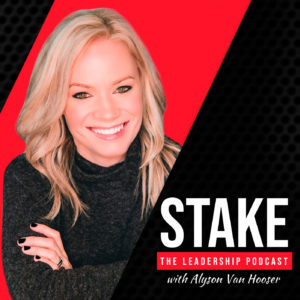
In this new show on the Compliance Podcast Network, Alyson Van Hooser is taking her breadth of experience – personal and professional – to explore and develop leaders across all industries.
The people who step up and take their place are the ones who will make the biggest change in the world. Alyson had to figure out a lot on her own as she was growing up, and that has inspired a passion for taking ownership of her own life and helping others do the same. When you take control of your own circumstances, you can change your reality to match your dreams.
Leadership comes from influence – and influence can go in all directions. Ultimately, the choice is whether or not you want to be a leader who makes incredible things happen. Alyson believes that the influence critical to leadership comes from serving people. Stories about the greatest leaders people have ever had have always been about those who wanted to serve others. Those stories and the lessons we learn from them are the focus of this podcast.
Listen Now:
Identify High-Caliber Future Leaders
I am kicking off STAKE: THE LEADERSHIP PODCAST by helping leaders do the most important part of their job–create the next generation of leaders.
How do you correctly identify high caliber future leaders?
How do you make sure you are not wasting resources on employees who will not step up to the plate?
How do you find the employees who will take your business to the next level?
In this episode, I am not talking about the obvious things you should be looking for such as high performance or relevant experience. Instead, I am talking about 4 very specific signs that come from those employees already showing the highest potential of becoming a successful future leader. Maybe you have been missing these signs all along? It is possible. However, once you have correctly identified your emerging leaders, the pressure is on for you to develop them!
Want me to train your emerging leaders for what it takes to successfully lead the 21st multi-generation workforce? Let’s talk! Email me: alyson@vanhooser.com
If you are looking for tangible action steps and refreshing insights to help ignite the power of your own leadership journey then
get my weekly newsletter here.
If this leadership podcast episode was valuable to you, please take a screenshot and tag me @AlysonVanHooser on your favorite social media [Instagram, LinkedIn, Facebook, Twitter].
Listen Now:
Give Your Ear, Get Their Loyalty
How do leaders increase employee retention?
How do leaders know what employees want?
Leaders have the power to influence their people in a way that will transform their business. But unless leaders learn the skill of listening at a high level, they will miss out on key information that will save them time, money, and a lot of headaches.
In this episode, I am talking about the importance of listening and sharing quick actions you can take TODAY to become a better listener–which will make you a better leader. When leaders focus on improving their listening skills then they can directly increase employee retention rates.
Want me to teach your leadership team how to listen in a way that transforms your business? Let’s talk! Email me: alyson@vanhooser.com
If you are looking for tangible action steps and refreshing insights to help ignite the power of your own leadership journey then
get my weekly newsletter here.
If this leadership podcast episode was valuable to you, please take a screenshot and tag me @AlysonVanHooser on your favorite social media [Instagram, LinkedIn, Facebook, Twitter]. I’ll share your comments and big takeaways on my feed!
Also, please make sure to review the podcast on iTunes (or Google Play, Stitcher, Android, TuneIn, Spotify). Thank you so much!
Listen Now:






